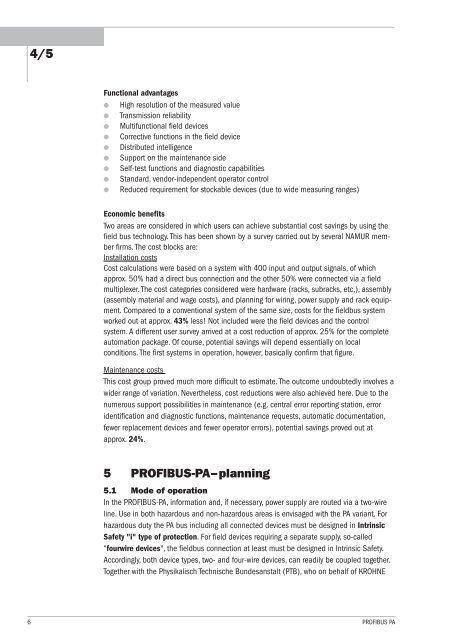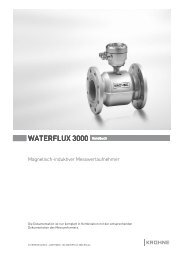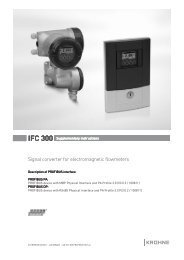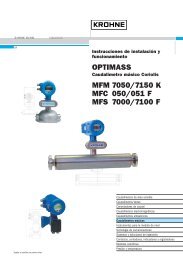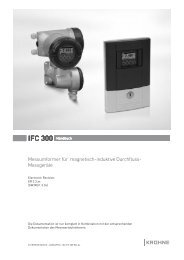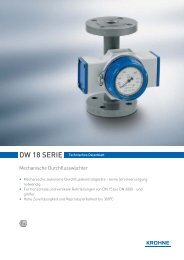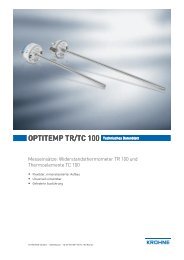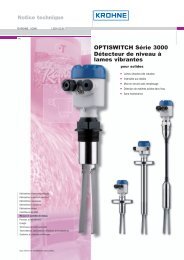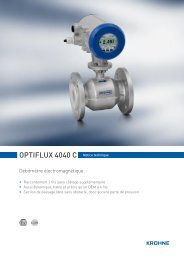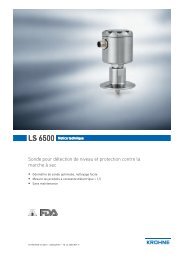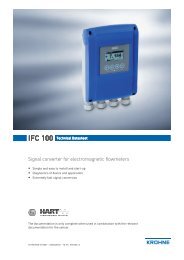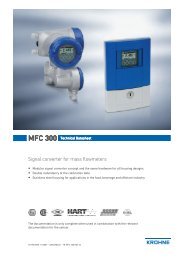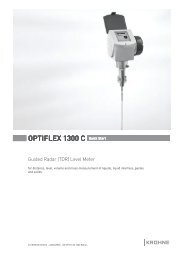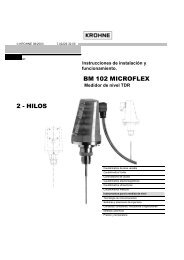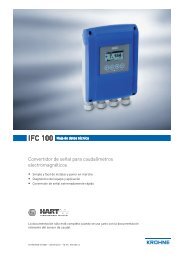Fundamentals of profibus pa networks - Krohne
Fundamentals of profibus pa networks - Krohne
Fundamentals of profibus pa networks - Krohne
Create successful ePaper yourself
Turn your PDF publications into a flip-book with our unique Google optimized e-Paper software.
4/5<br />
Functional advantages<br />
● High resolution <strong>of</strong> the measured value<br />
● Transmission reliability<br />
● Multifunctional field devices<br />
● Corrective functions in the field device<br />
● Distributed intelligence<br />
● Support on the maintenance side<br />
● Self-test functions and diagnostic ca<strong>pa</strong>bilities<br />
● Standard, vendor-independent operator control<br />
● Reduced requirement for stockable devices (due to wide measuring ranges)<br />
Economic benefits<br />
Two areas are considered in which users can achieve substantial cost savings by using the<br />
field bus technology. This has been shown by a survey carried out by several NAMUR member<br />
firms. The cost blocks are:<br />
Installation costs<br />
Cost calculations were based on a system with 400 input and output signals, <strong>of</strong> which<br />
approx. 50% had a direct bus connection and the other 50% were connected via a field<br />
multiplexer. The cost categories considered were hardware (racks, subracks, etc,), assembly<br />
(assembly material and wage costs), and planning for wiring, power supply and rack equipment.<br />
Com<strong>pa</strong>red to a conventional system <strong>of</strong> the same size, costs for the fieldbus system<br />
worked out at approx. 43% less! Not included were the field devices and the control<br />
system. A different user survey arrived at a cost reduction <strong>of</strong> approx. 25% for the complete<br />
automation <strong>pa</strong>ckage. Of course, potential savings will depend essentially on local<br />
conditions. The first systems in operation, however, basically confirm that figure.<br />
Maintenance costs<br />
This cost group proved much more difficult to estimate. The outcome undoubtedly involves a<br />
wider range <strong>of</strong> variation. Nevertheless, cost reductions were also achieved here. Due to the<br />
numerous support possibilities in maintenance (e.g. central error reporting station, error<br />
identification and diagnostic functions, maintenance requests, automatic documentation,<br />
fewer replacement devices and fewer operator errors), potential savings proved out at<br />
approx. 24%.<br />
5 PROFIBUS-PA–planning<br />
5.1 Mode <strong>of</strong> operation<br />
In the PROFIBUS-PA, information and, if necessary, power supply are routed via a two-wire<br />
line. Use in both hazardous and non-hazardous areas is envisaged with the PA variant. For<br />
hazardous duty the PA bus including all connected devices must be designed in Intrinsic<br />
Safety "i" type <strong>of</strong> protection. For field devices requiring a se<strong>pa</strong>rate supply, so-called<br />
“fourwire devices", the fieldbus connection at least must be designed in Intrinsic Safety.<br />
Accordingly, both device types, two- and four-wire devices, can readily be coupled together.<br />
Together with the Physikalisch Technische Bundesanstalt (PTB), who on behalf <strong>of</strong> KROHNE<br />
6 PROFIBUS PA


